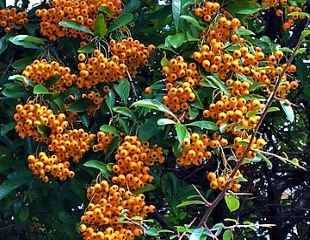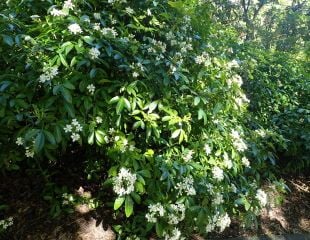Fast Growing Evergreen Shrubs
I get a lot of questions about fast growing evergreen shrubs. We all like privacy in our gardens, and sometimes there is a need to create a hedge or buffer quickly, but avoiding the blandness of conifers and problems of Leylandii.
If you are planning a hedge or screen in proximity to your neighbours, be aware of the law. As an alternative, you could consider planting a deciduous hedge, such as a Fagus, the common Beech, which is fast growing and not evergreen. It gives privacy but is a less dense shrub, creating less shade.
You can plant shrubs at any time of year providing it is not a cold spell. The main cause that shrubs failing to thrive is a lack of water. After you plant a shrub, you should water it regularly for weeks to help it establish. This makes autumn a good time to plant shrubs because it is much wetter that any other of the seasons.
Planting a fast-growing shrub is good in some ways as it produces an instant result. By its nature, a fast-growing hedge produces a lot of growth quickly and so will need regular pruning. It can also produce very dense shade around it. It is important to view the space and surroundings before deciding. For example, Portuguese laurel is correctly billed as a fast-growing evergreen, but it also gets very large and in around 7 years can reach 7m and 2/3m wide, which if planted on a boundary could swamp the area and be unmanageable.
It is a question of balance. The need for privacy or cover weighed against the ultimate size of the evergreen, how quickly and the amount of maintenance. It is great to get the cover, but you do not want to have to spend time or money cutting back to prevent the evergreen from taking over. With that caveat, there are a good number of easy, fast-growing evergreen shrubs.
There are also many lovely evergreen shrubs which a moderately fast growing. These can be easier to maintain, less pruning, and more suited to the average sized garden. Suttons have a wide range of shrubs, including those featured many at discounted prices. Browse the collection.
Did you know some shrubs can reduce air pollution. If you live near a busy main road, planting these shrubs can help combat air pollution. Check out 10 best hedges and shrubs for wildlife and pollution busting.
Thinking of planting bamboo to provide a quick screen? plant with caution, as bamboo can be very vigorous. Check out my guide to planting non invasive bamboo in the garden for hints, tips and a complete list of invasive and noninvasive bamboo varieties.
Photinia

Photinia is fast growing and a popular variety is P. 'Red Robin'. It will grow up to 5m in height and spread, and can be contained by regular pruning. Should the shrub become overgrown, it will respond to hard pruning.
The fresh growth is an attractive bright red in the spring. Photinia Easy to grow, not fussy about soil types and Hardy H5/H4.
Escallonia
Escallonia is fast growing and makes a great hedge. It is evergreen with glossy waxy leaves and lovely pink or white flowers. Unfortunately, it is not fully hardy everywhere in the UK, this hedge was growing in Guernsey, but it will grow in many parts of the UK with some shelter. For growing tips and advice on the hardiest varieties to grow.
Choiysa
Choiysa is another fast-growing shrub, although not as large as some others. The most popular varieties C. 'Aztec Pearl' and 'ternata' both reach around 2.5m. The up side is that Choiysa is a very attractive shrub, with glossy leaves and highly scented flowers- and easy to grow; tips on growing.
Suttons have a lovely selection of 10 Choiysa to select from, including the popular C.ternata and scented gem.
Pyracantha

Pyracantha are fast growing and tolerant of most growing conditions. This is Pyracantha ' Orange Glow' which has orange berries and there are also varieties with bright red berries. Pyracanthas will reach a height of between 3-4m and will grow in partial shade. Pyracantha will attract bees to the summer flowers and birds for the autumn berries.
Portuguese laurel

Prunus lusitanica, the Portuguese laurel has attractive leaves, dark green with small white flowers in the spring.
In the right conditions, it is very fast growing up to a height of 12m and above. It has dense growth which will create a complete barrier, but also a lot of shade. Take care when planting to ensure it doesn't overshadow where it is not wanted.
Clematis Armandii
If you are fortunate to have the right growing conditions, Clematis Armandii is a fast-growing evergreen climbing Clematis which will grow to around 8 meters in around 5-10 years depending on the conditions. To look good, retain its leaves and evergreen status, C. Armandii requires a warm sheltered spot but rewards with lovely glossy leaves and scented flowers. It is a group 1 Clematis so does not require routine pruning. Information on planting and growing Clematis. Illustrated is Clematis armandii ' Apple blossom' more information on types of Clematis.
Common Beech

Although not evergreen, well worth considering Fagus sylvatica the Common Beech. It makes a beautiful hedge with so much interest. Illustrated is the Autumn colour, which is followed by brown leaves which stay in place for most of the winter. The new growth in spring is vivid green. It is not fussy about growing conditions, and will reach an ultimate height of around 15m. Birds love to nest in it. For this reason, it is pruned after August, as it is an offence under the Wildlife & Countryside Act 1981 to damage or destroy the nest of any wild bird while it is in use or being built. It makes a really stylish hedge.
Elaeagnus

Elaeagnus is quick growing evergreens which make a good hedge, illustrated is E.x ebbingei 'Gilt Edge' another popular variety is 'limelight', and there are a good selection of evergreen varieties to choose from. It is a tough shrub which will grow in most conditions, any new shoots which do not display variegation prune out to keep the bright colour.
Expect average growth rates of around 30-50cms per annum
Mahonia

Some, but not all Mahonia are fast growing. If you are looking for the fast growing varieties try Mahonia x media Winter Sun. Most of the tall upright Mahonia media are medium to fast growing whilst the low growing ground cover varieties are slower growing.
Ceanothus

Ceanothus is fast growing, but short-lived shrubs. Glossy, evergreen leaves with a profusion of soft blue flowers Ceanothus are well worth the effort even if they do run out of steam after a decade or so.
Ceanothus is particular about their growing conditions. Known as the California Lilac Ceanothus needs a sheltered spot.
Portugese Laurel

This is not the best image of Portuguese laurel, Prunus lusitanica, but it does show how very large the shrub grows in a matter of a few years. You can keep it in check by pruning, but that means pruning every year, so the first decision is do you want to plant a shrub which requires very regular pruning? If so prune early in the year before the birds nest.
It will grow in sun or partial shade and is very hardy. Portuguese laurel can be planted and will form a hedge withing about 3 years.
Cotoneasters

Cotoneaster is a genus of 200 species of evergreen and semi evergreen shrubs and trees.
Suitable for our gardens (with a suitable size warning) are C. Franchetti, which is evergreen or semi evergreen depending on the growing conditions. It will retain more leaves in sheltered gardens. It will grow at the rate of between 20-40 cm per year and reach around 3 metres. C. lacteus grows at the same rate but is smaller around 1-2m. Both have white flowers in spring, berries in the autumn and are good for wildlife.
Fatsia Japonica

Fatsia Japonica also known as the Castor Oil Plant, is an easy to grow evergreen shrub. It will grow in sun, partial shade, and shade including dry shade (once established.)
It is tolerant of all types of soils and fully hardy. It is an architectual shrub with a distinct shape and form. I think of it as a marmite shrub as it is definitely some love it and some hate it.
It will fill a gap quickly especially in ideal growing conditions, when it will grow around 30cm or 1 ft per year.
Can I plant Leylandii and other hedge issues?
It is not illegal to plant Leylandii, but there are restrictions and specific regulations concerning evergreen hedges. Your neighbours can complain to the local council if the trees or hedge you plant breaches the Anti-Social Behaviour Act (2003)
This law applies to hedges consisting of two or more evergreens, or mostly evergreen trees (not to individual trees) and hedges over two metres affecting domestic property. This means is that if you pick a shrub which is quick growing, you will need to be scrupulous with maintenance and pruning so as not to offend neighbours and the law. If in doubt, take legal advice from an appropriate source, such as Citizens Advice or a solicitor.
Hedges for Health
If you live in an urban area, or close to a busy road, a hedge can help clean the air around your property. There has been some very useful scientific research by the RHS about this issue, and some shrubs are better at collecting particulates than others. Planting a hedge really can help to improve the air quality around your home.
For more information about the best shrubs to grow to tackle pollution and particulates, follow this link.





